Mineralogical Characterization of Early Bronze Age Pottery from the Svilengrad-Brantiite Site, Southeastern Bulgaria
Abstract
:1. Introduction
2. Materials and Methods
2.1. Materials
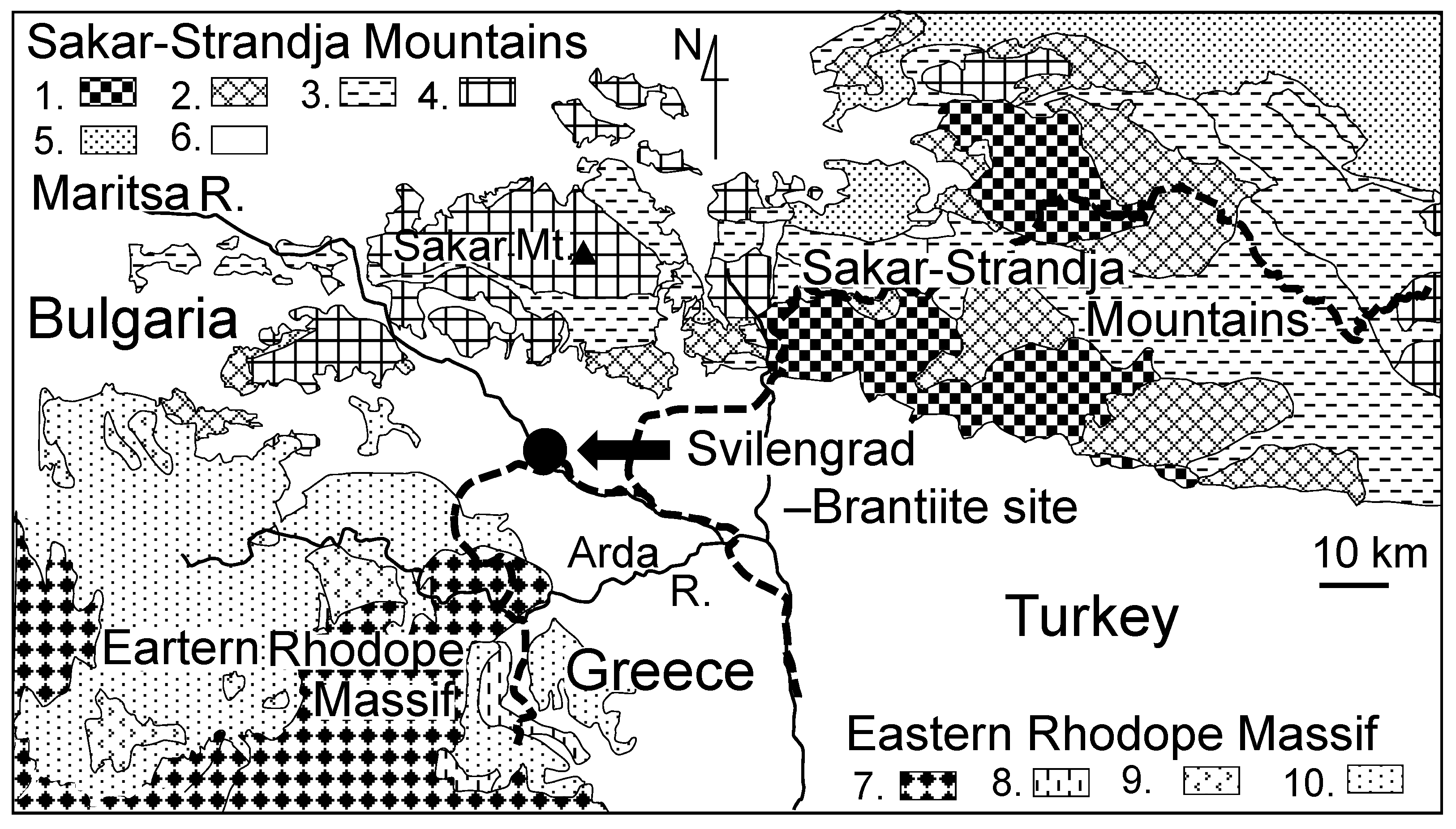
2.2. Methods
3. Results
3.1. Features of Pottery Samples and Clay Paste
3.2. Mineral Grains
3.3. Rock Fragments
3.4. Chemical Composition of Clay Paste
3.5. X-ray Fluorescence (XRF)
3.6. X-ray Diffraction (XRD)
4. Discussion
4.1. Origin and Source of the Mineral Grains and Rock Fragments
4.2. Chemical Features of the Clay Paste
4.3. Estimated Firing Temperature
4.4. Relationship between Petrographic and Typological Features of Pottery
5. Conclusions
Author Contributions
Funding
Data Availability Statement
Acknowledgments
Conflicts of Interest
References
- RAnthony, D.W. The Horse, the Wheel, and Language: How Bronze-Age Riders from the Eurasian Steppes Shapes the Modern World; Princeton University Press: Princeton, NJ, USA, 2007. [Google Scholar]
- Heyd, V. Yamnaya Groups and Tumuli west of the Black Sea. In Ancestral Landscape. Burial Mounds in the Copper and Bronze Ages (Central and Eastern Europe–Balkans–Adriatic–Aegean, 4th-2nd millennium B.C.); Borgna, E., Müller-Celka, S., Eds.; Travaux de la Maison de l’Orient, TMO 58; Maison Orient: Lyon, France, 2011; pp. 535–555. [Google Scholar]
- Georgiev, G. Beiträge zur Erforschung des Neolithikums und der Bronzezeit in Südbulgarien. Arch. Austr. 1967, 42, 90–144. [Google Scholar]
- Roman, P.; Dodd-Oprițescu, A.; János, P.; Hauptmann, H.; Schrickel, W. Beiträge zur Problematik der Schnurverzierten Keramik Südosteuropas; P. von Zabern: Mainz am Rhein, Germany, 1992. [Google Scholar]
- Nikolova, L. Data about sea contacts during the Early Bronze Age in south-eastern Europe (c. 3500/3400-2350/2250 B.C.). Thracia Pontica 1994, 5, 57–86. [Google Scholar]
- Lichardus, J.; Lichardus-Itten, M. Nordpontsche Beziehungen wärend der frühen Vorgeschichte Bulgariens. Thracia 1995, 11, 31–62. [Google Scholar]
- Leshtakov, K.; Tsirtsoni, Z. Caesurae in the Bronze Age chronology of Eastern Bulgaria. In Der Schwarzmeerraum vom Neolithikum bis in Die Früheisenzeit (6000–600 v. Chr.). Kulturelle Interferenzen in der Zirkumpontischen Zone und Kontakte mit Ihren Nachbargebieten; Nikolov, V., Schier, W., Eds.; Verlag Marie Leidorf GhmH: Rahden, Germany, 2016; pp. 477–491. [Google Scholar]
- Harrison, R.J.; Heyd, V. The transformation of Europe in the third millennium BC: The example of ‘Le Petit Chasseur I+III’ (Sion, Valais, Switzerland). Praehist. Z 2007, 82, 129–214. [Google Scholar] [CrossRef]
- Semmoto, M. Chronology and Regional Interaction on Pottery in Early Bronze Age, Bulgaria: Focusing on Material Analysis of Tell Dyadovo. Ph.D. Thesis, Tokai University, Kanagawa, Japan, 2015. [Google Scholar]
- Leshtakov, K. Troy and upper Thrace: What happened in the EBA 3? (Interrelations Based on Pottery Evidence). In Early Bronze Age Troy: Chronology, Cultural Developments and Interregional Contacts; Pernicka, E., Ünlüsoy, S., Blum, S., Eds.; Verlag Dr. Rudolf Habelt: Bonn, Germany, 2016; pp. 239–255. [Google Scholar]
- Semmoto, M.; Kannari, T.; Shibata, T.; Leshtakov, K. Petrographic and Chemical characterization of Early Bronze Age pottery from Sokol Himitliyata in Nova Zagora Region: An interim report. Stud. Archaeol. Univ. Serdicensis Diss. Ser. 2018, 6, 153–167. [Google Scholar]
- Leshtakov, K.; Machev, P.; Popova, T.; Vangelov, D.; Vangelova, V.; Stoilkova, T.; Petrova, V.; Ilieva, D.; Nikolova, N.; Chavdarova, S.; et al. Social dimensions of technology of ceramic production in southeast Bulgaria in 6th-2nd mill. BC. Interdiscip. Stud. 2019, 26, 33–106. [Google Scholar]
- Nekhrizov, G.; Tzvetkova, J. Iron Age ritual pits near Svilengrad. In Spasitelni Arheologicheski Razkopki po Traseto na Zhelezopatnata Liniya Plovdiv-Svilengrad Prez 2005 [Rescue Excavations along the Route of the Plovdiv-Svilengrad Railway in 2005]; Nikolov, V., Nekhrizov, G., Tzvetkova, J., Eds.; Faber: Veliko Tarnovo, Bulgaria, 2008; pp. 331–493. [Google Scholar]
- Nekhrizov, G. Iron Age pit sanctuary and Early Bronze Age settlement near the town of Svilengrad. In Spasitelni Arheologicheski Razkopki po Traseto na Zhelezopatnata Liniya Plovdiv-Svilengrad Prez 2004 [Rescue Excavations along the Route of the Plovdiv-Svilengrad Railway in 2004]; Nikolov, V., Nekhrizov, G., Tzvetkova, J., Eds.; Faber: Veliko Tarnovo, Bulgaria, 2006; pp. 397–548. [Google Scholar]
- Valentinova, M.; Nenova, D. Early Bronze Age site near Svilengrad. In Spasitelni Arheologicheski Razkopki po Traseto na Zhelezopatnata Liniya Plovdiv-Svilengrad Prez 2005 [Rescue Excavations along the Route of the Plovdiv-Svilengrad Railway in 2005]; Nikolov, V., Nekhrizov, G., Tzvetkova, J., Eds.; Faber: Veliko Tarnovo, Bulgaria, 2008; pp. 494–526. [Google Scholar]
- Kozhoukharov, D.; Boyanov, I.; Kozhoukharova, E.; Goranov, A.; Savov, S.; Shilyafov, G. Explanatory Note to the Geological Map of Bulgaria on Scale 1:100000, Svilengrad Map Sheet; Geology and Geophysics Corporation: Sofia, Bulgaria, 1995. [Google Scholar]
- Okay, A.; Satır, M.; Tüysüz, O.; Akyüz, S.; Chen, F. The tectonics of the Strandja Massif: Late-Variscan and mid-Mesozoic deformation and metamorphism in the northern Aegean. Int. J. Earth Sci. 2001, 90, 217–233. [Google Scholar] [CrossRef]
- Gerdjikov, I. Alpine metamorphism and granitoid magmatism in the Strandja Zone: New data from the Sakar Unit, SE Bulgaria. Turkish J. Earth Sci. 2005, 14, 167–183. [Google Scholar]
- Sunal, G.; Satir, M.; Natal’in, B.A.; Topuz, G.; Vonderschmidt, O. Metamorphism and diachronous cooling in a contractional orogen: The Strandja Massif, NW Turkey. Geol. Mag. 2011, 148, 580–596. [Google Scholar] [CrossRef]
- Marchev, P.; Ganev, V.; Klain, L. New LA-ICP-MS U-Pb zircon dating for Strandja granitoids (SE Bulgaria): Evidence for two-stage late Variscan magmatism in the internal Balkanides. Turkish J. Earth Sci. 2015, 24, 230–248. [Google Scholar] [CrossRef]
- Tzankova, N. Chemical characterization of garnets and P-T conditions of metamorphism of the Triassic rocks occurring to the south of Oreschnik, South-East Bulgaria. Ann. Univ. Min. Geol. St. Ivan Rilski 2005, 48, 155–160. [Google Scholar]
- Tzankova, N.; Petrov, O. ICP AES, microprobe, and X-ray powder diffraction data for garnets from metamorphic rocks in the Sakar region, SE Bulgaria. Geochem. Mineral. Petrol.∙Sofia 2006, 44, 73–89. [Google Scholar]
- Kamenov, B.K.; Vergilov, V.; Dabovski, C.; Vergilov, I.; Ivchinova, L. The Sakar batholith–petrology, geochemistry and magmatic evolution. Geochem. Mineral. Petrol.∙Sofia 2010, 48, 1–37. [Google Scholar]
- Schaller, M.; Lachner, J.; Christl, M.; Maden, C.; Spassov, N.; Ilg, A.; Böhme, M. Authigenic Be as a tool to date river terrace sediments?—An example from a Late Miocene hominid locality in Bulgaria. Quat. Geochronol. 2015, 29, 6–15. [Google Scholar]
- Ivanov, D.; Lazarova, M. Past climate and vegetation in Southeast Bulgaria—A study based on the late Miocene pollen record from the Tundzha Basin. J. Palaeogeogr. 2019, 8, 3. [Google Scholar] [CrossRef] [Green Version]
- Caracciolo, L.; Orlando, A.; Critelli, S.; Kolios, N.; Manetti, P.; Marchev, P. The Tertiary Trace Basin of SE Bulgaria and NE Greece: A review of petrological and mineralogical data of sedimentary sequences. Acta Vulcanol. 2015, 25, 21–41. [Google Scholar]
- Mposkos, E.; Liati, A. Metamorphic evolution of metapelites in the high-pressure terrane of the Rhodope zone, northern Greece. Can. Mineral. 1993, 31, 401–424. [Google Scholar] [CrossRef]
- Marchev, P.; Raicheva, R.; Downes, H.; Vaselli, O.; Chiaradia, M.; Moritz, R. Compositional diversity of Eocene–Oligocene basaltic magmatism in the Eastern Rhodopes, SE Bulgaria: Implications for genesis and tectonic setting. Tectonophysics 2004, 393, 301–328. [Google Scholar] [CrossRef]
- Nagel, T.J.; Schmidt, S.; Janák, M.; Froitzheim, N.; Jahn-Awe, S.; Georgiev, N. The exposed base of a collapsing wedge: The Nestos Shear Zone (Rhodope metamorphic province, Greece). Tectonics 2011, 30, TC4009. [Google Scholar] [CrossRef]
- Bonev, N.; Ovtcharova-Schaltegger, M.; Moritz, M.R.; Marchev, P.; Ulianov, A. Peri-Gondwanan Ordovician crustal fragments in the high-grade basement of the Eastern Rhodope Massif, Bulgaria: Evidence from U-Pb LA-ICP-MS zircon geochronology and geochemistry. Geodin. Acta 2013, 26, 207–229. [Google Scholar] [CrossRef]
- Mposkos, E. High-pressure metamorphism in gneisses and pelitic schists in the East Rhodope Zone (N. Greece). Mineral. Petrol. 1989, 41, 25–39. [Google Scholar] [CrossRef]
- Yanev, Y.; Ivanova, R. Mineral chemistry of the collision-related acid Paleogene volcanic rocks of the Eastern Rhodopes, Bulgaria. Geochem. Mineral. Petrol.∙Sofia 2010, 48, 39–65. [Google Scholar]
- Raicheva, R.; Marchev, P.; Georgiev, S.; Ichev, M. Geochemistry, mineral composition and conditions of crystallization of accessory-rich gabbro associated with adakitic rocks of the Drangovo pluton, Rhodope Massif. C. R. Acad. Bulg. Sci. 2018, 71, 220–229. [Google Scholar]
- Caracciolo, L.; Orlando, A.; Marchev, P.; Critelli, S.; Manetti, P.; Raycheva, R.; Riley, D. Provenance of Tertiary volcanoclastic sediment in NW Thrace (Bulgaria): Evidence from detrital amphibole and pyroxene geochemistry. Sediment. Geol. 2016, 336, 120–137. [Google Scholar] [CrossRef]
- Chavdarova, S.; Machev, P. Amphibolites from Sakar Mountain—geological position and petrological features. In Proceedings of the Bulgarian Geological Society, National Conference with International Participation “Geosciences 2017”, Sofia, Bulgaria, 7–8 November 2017; pp. 49–50. [Google Scholar]
- Raeva, E.; Cherneva, Z. Metamorphic grade of the Madan unit in the southern part of the Central Rhodopes, Bulgaria. Geochem. Mineral. Petrol. Sofia 2009, 47, 135–161. [Google Scholar]
- Moulas, E.; Schenker, F.L.; Burg, J.P.; Kostopoulos, D. Metamorphic conditions and structural evolution of the Kesebir-Kardamos dome: Rhodope metamorphic complex (Greece-Bulgaria). Int. J. Earth Sci. 2017, 106, 2667–2685. [Google Scholar] [CrossRef] [Green Version]
- Braekmans, D.; Degryse, P. Petrography: Optical microscopy. In The Oxford Handbook of Archaeological Ceramic Analysis; Hunt, A.M.W., Ed.; Oxford University Press: Oxford, UK, 2016; pp. 233–265. [Google Scholar]
- Maniatis, Y.; Tite, M.S. Technological Examination of Neolithic-Bronze Age pottery from central and southeast Europe and from the Near East. J. Archeol. Sci. 1981, 8, 59–76. [Google Scholar] [CrossRef]
- Ionescu, C.; Hoeck, V.; Ghergari, L. Electron microprobe analysis of ancient ceramics: A case study from Romania. Appl. Clay Sci. 2011, 53, 466–475. [Google Scholar] [CrossRef]
- Wilson, M.J. Sheet Silicates: Clay Minerals, Rock-Forming Minerals; The Geological Society of London: London, UK, 2013; Volume 3C. [Google Scholar]
- Yaneva, M. Comperative sedimentologic characteristics of young sediments (Pliocene–Holocen) disturbed by Chirpan Fault. Rev. Bulgarian Geol. Soc. 2006, 67, 41–49. [Google Scholar]
- Yaneva, M.; Lazarova, M. Preliminary sedimentological and palynological studies of Quaternary deposits from paleoseismological trench “Cherna Gora”, Chirpan district. C. R. Acad. Bulg. Sci. 2004, 57, 71–76. [Google Scholar]
- Yaneva, M.; Todorova, N.; Katsarov, G.; Petrova, V.; Bacvarov, K. By the rivers of Nova Nadezhda: Dynamics of human–environment interaction at a prehistoric site in Upper Thrace. Geol. Balc. 2017, 46, 65–72. [Google Scholar]
- Arnold, D. Ceramic Theory and Cultural Process; Cambridge University Press: Cambridge, UK, 1985. [Google Scholar]
- Pristavova, S.; Tzankova, N.; Gospodinov, N.; Filipov, P. Petrological study of metasomatic altered granitoids from Kanarata deposit, Sakar Mountain, southeastern Bulgaria. J. Mining Geol. Sci. 2019, 62, 53–61. [Google Scholar]
- Chamley, H. Clay Sedimentation; Springer: Berlin/Heidelberg, Germany, 1989. [Google Scholar]
- Ilieva, A.; Milakovska, Z. Mineral composition of the clay fractions from sediments of Troianovo-North mine, East Maritza Basin (Bulgaria). In Proceedings of the Annual Scientific Conference of the Bulgarian Geological Society, GEOSCIENCES 2007, Sofia, Bulgaria, 13–14 November 2017; pp. 39–41. [Google Scholar]
- Riccardi, M.P.; Messiga, B.; Duminuco, P. An approach to the dynamics of clay firing. Appl. Clay Sci. 1999, 15, 393–409. [Google Scholar] [CrossRef]
- Hajjaji, M.; Kacim, S.; Boulmane, M. Mineralogy and firing characteristics of a clay from the valley of Ourika (Morocco). Appl. Clay Sci. 2002, 21, 203–212. [Google Scholar] [CrossRef]
- Papadopouloul, D.N.; Lalia-Kantouri, M.; Kantiranis, N.; Stratis, J.A. Thermal and mineralogical contribution to the ancient ceramics and natural clays characterization. J. Therm. Anal. Calorim. 2006, 84, 39–45. [Google Scholar] [CrossRef]
- Ortega, L.A.; Zuluaga, M.C.; Alonso-Olazabal, A.; Murelaga, X.; Alday, A. Petrographic and geochemical evidence for long-standing supply of raw materials in Neolithic pottery (Mendandia site, Spain). Archaeometry 2010, 52, 987–1001. [Google Scholar] [CrossRef]
- Maniatis, Y.; Simopoulos, A.; Kostikas, A.; Perdikatsis, V. Effect of reducing atmosphere on minerals and iron oxides developed in fired clays: The role of Ca. J. Am. Ceram. Soc. 1983, 66, 773–781. [Google Scholar] [CrossRef]
- Maggetti, M.; Neururer, C.; Ramseyer, D. Temperature evolution inside a pot during experimental surface (bonfire) firing. Appl. Clay Sci. 2011, 53, 500–508. [Google Scholar] [CrossRef] [Green Version]
- Kostadinova-Avramova, M.; Jordanova, N.; Jordanova, D.; Grigorov, V.; Lesigyarski, D.; Dimitrov, P.; Bozhinova, E. Firing temperatures of ceramics from Bulgaria determined by rock-magnetic studies. J. Archeol. Sci. Rep. 2018, 17, 617–633. [Google Scholar] [CrossRef]
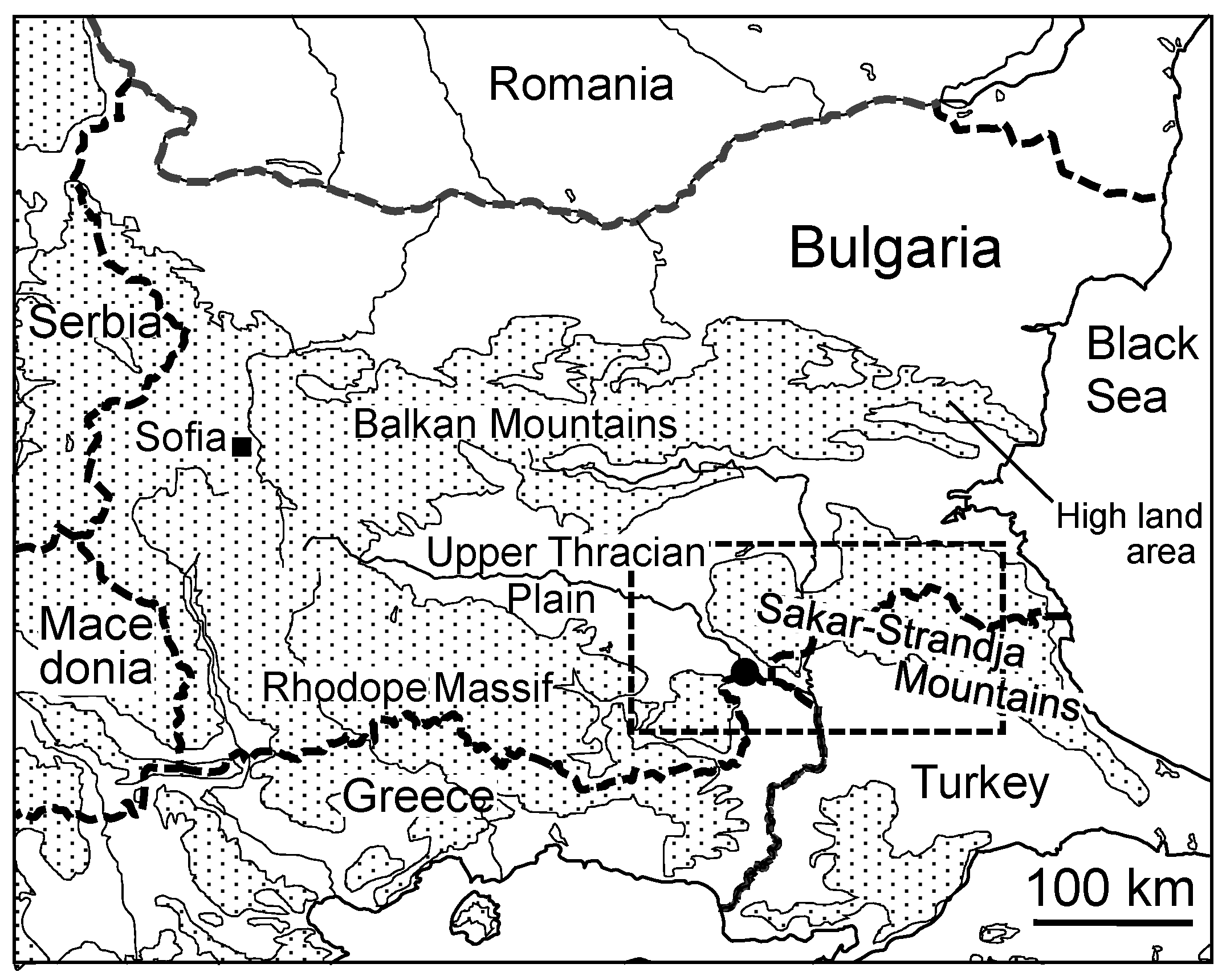
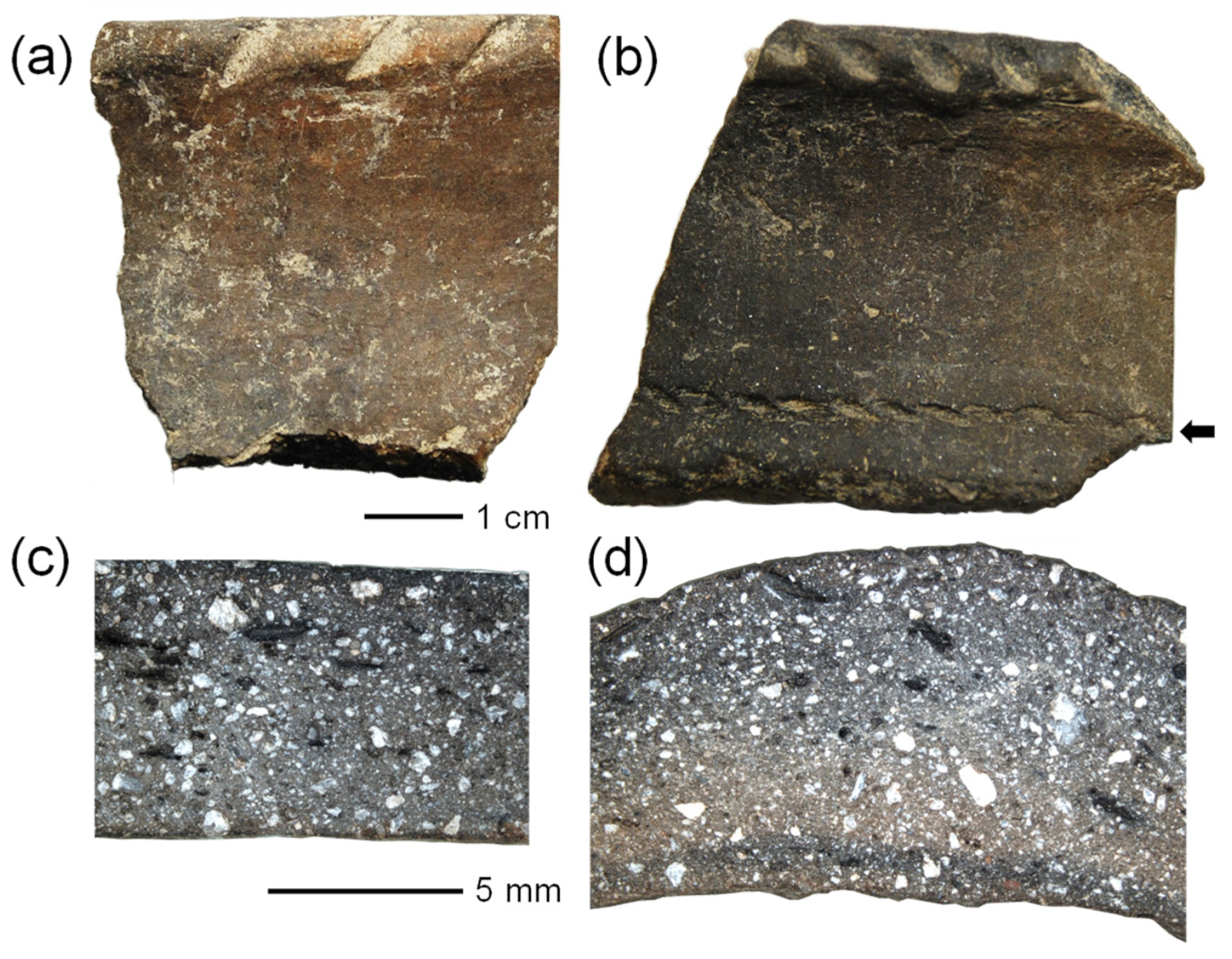
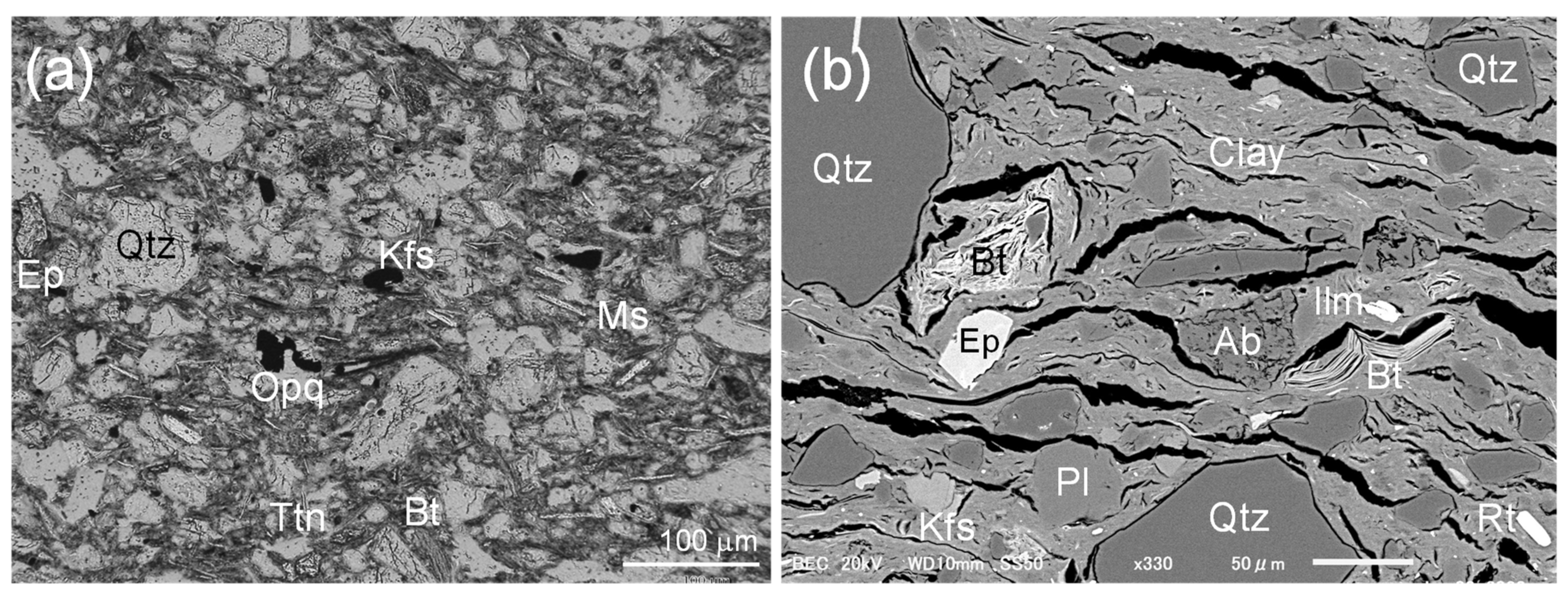
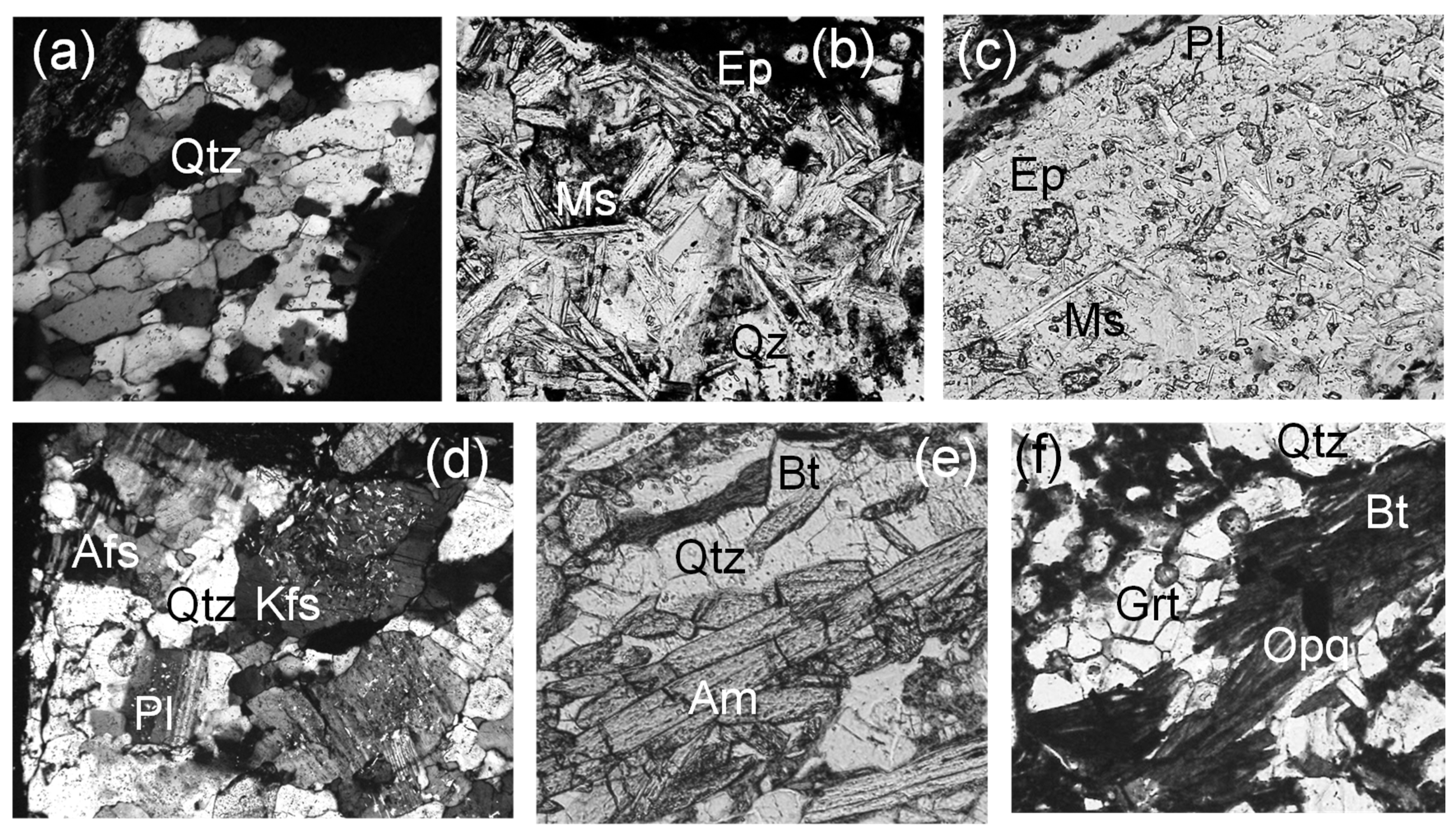
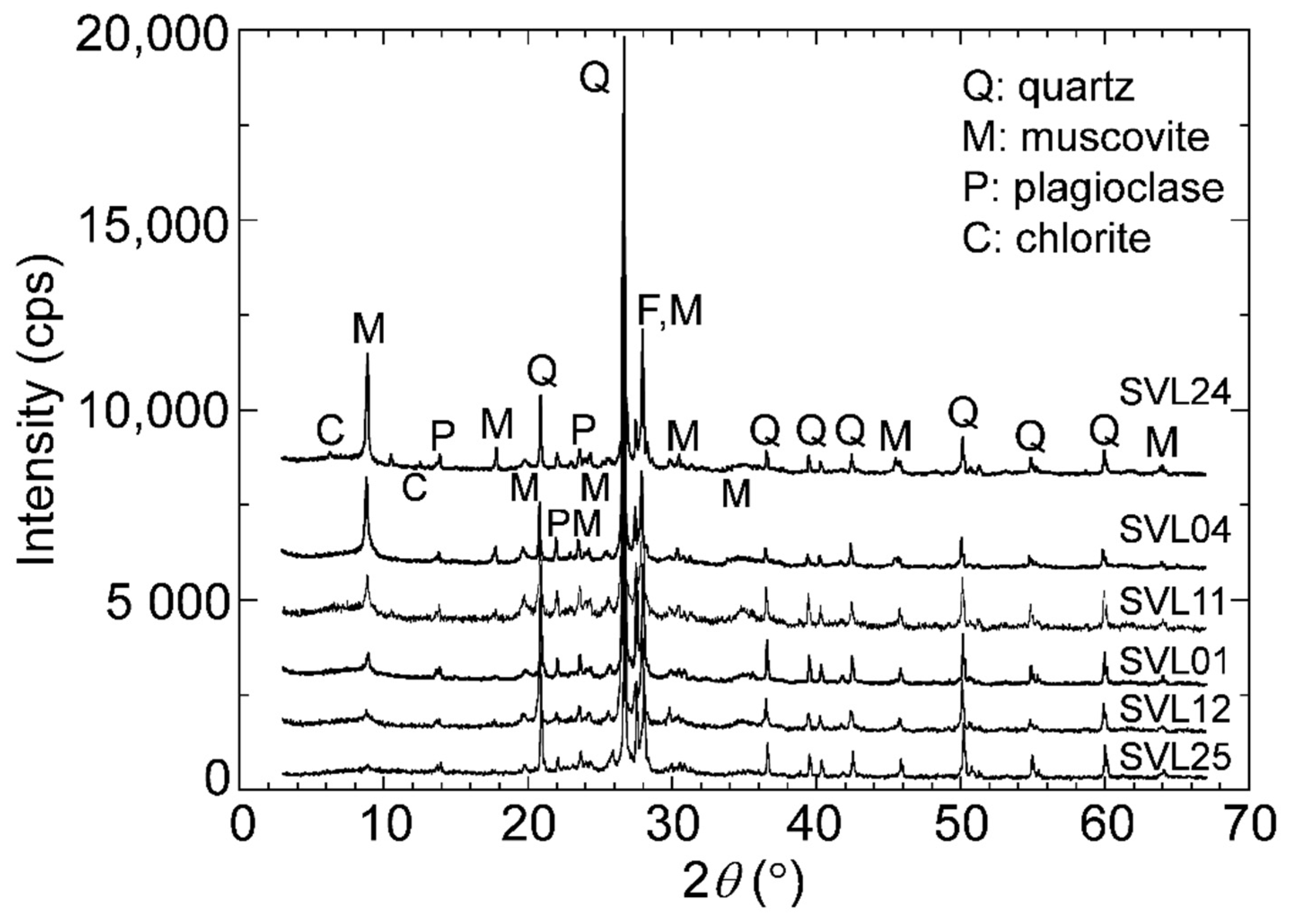
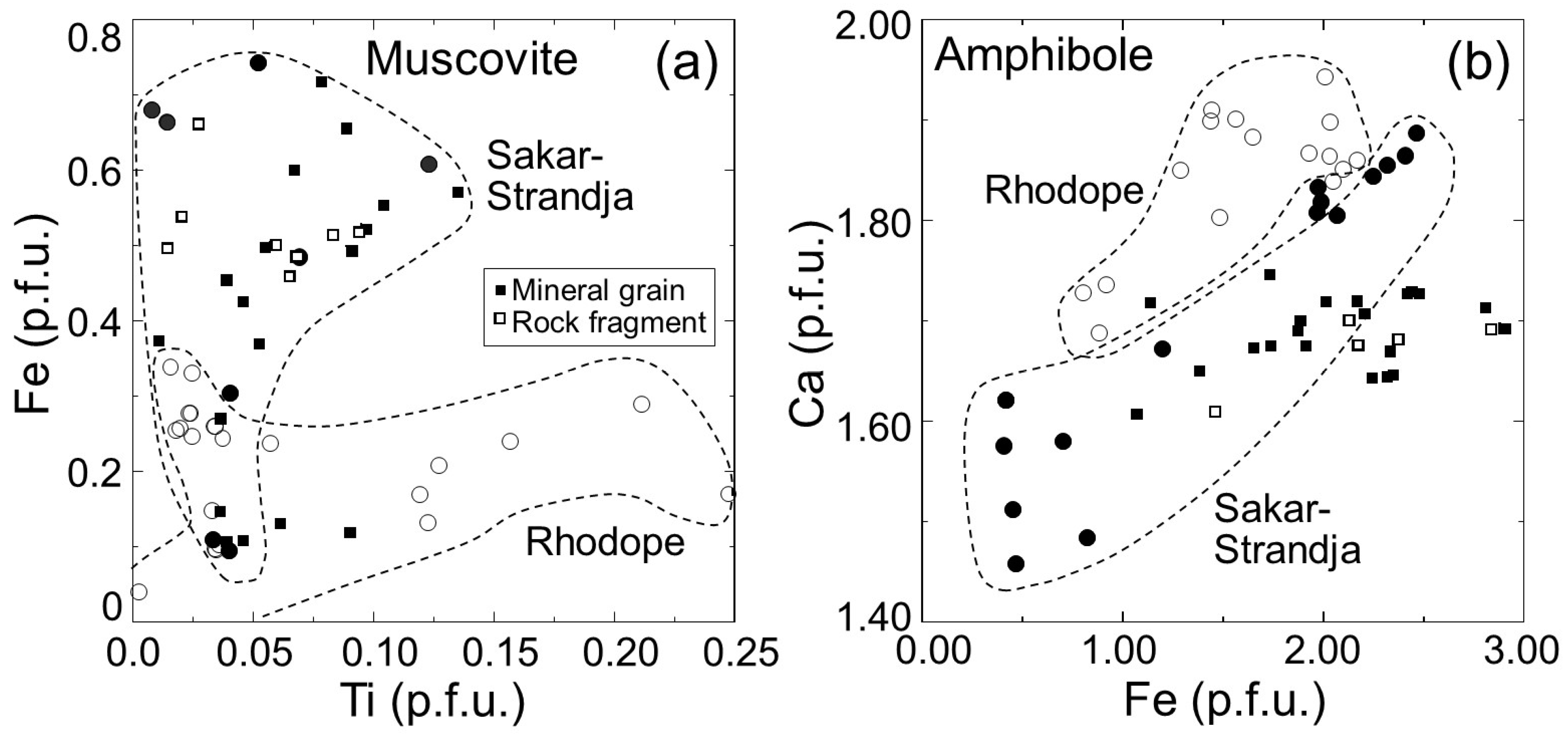
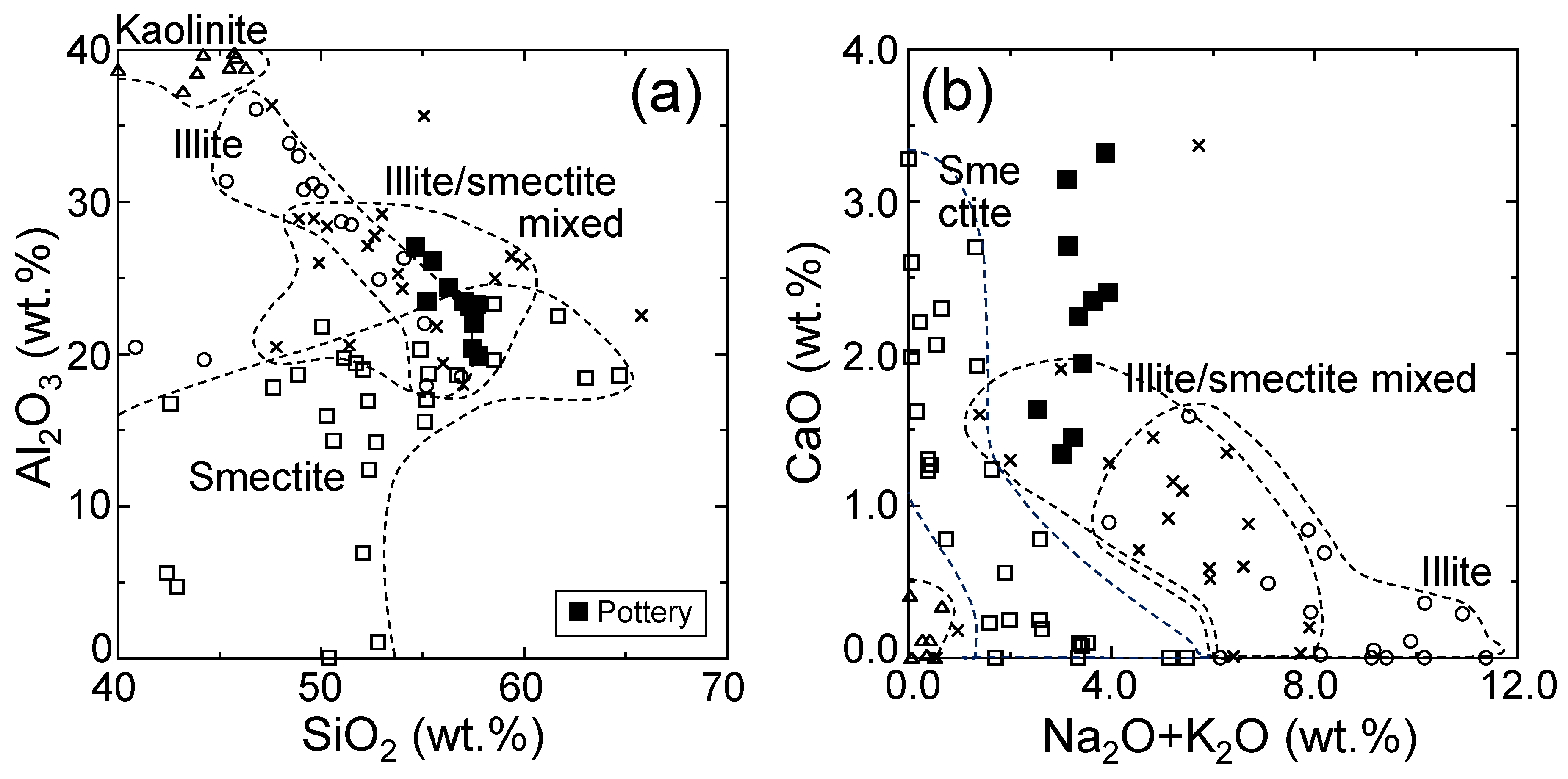
| Sample | Type (mm) | Thickness | Surface Color | Internal Color | Mineral Grains | Observed by Optical Microscope | ||||||||||||
|---|---|---|---|---|---|---|---|---|---|---|---|---|---|---|---|---|---|---|
| Major Species | Minor Species | |||||||||||||||||
| Qtz | Kfs | Mc | Pl | Afs | Ms | Ep | Bt | Opq | Ttn | Am | Grt | Chl | St | |||||
| SVL01 | EBA2 | 8 | Dark brown | Dark brown | x | x | x | x | x | x | x | x | x | x | x | x | x | |
| SVL02 | EBA2 | 7 | Dark brown | Dark brown | x | x | x | x | x | x | x | x | x | x | x | |||
| SVL03 | EBA2 | 10 | Dark brown | Dark brown | x | x | x | x | x | x | x | x | x | x | x | |||
| SVL04 | EBA2 | 6 | Dark brown | Dark brown | x | x | x | x | x | x | x | x | x | x | x | x | x | |
| SVL05 | EBA2 | 6 | Dark brown | Dark brown | x | x | x | x | x | x | x | x | x | x | x | x | x | |
| SVL06 | EBA2 | 7 | Dark brown | Dark brown | x | x | x | x | x | x | x | x | x | x | x | x | ||
| SVL07 | EBA2 | 8 | Dark brown | Dark brown | x | x | x | x | x | x | x | x | x | x | x | x | ||
| SVL08 | EBA2 | 7 | Dark brown | Dark brown | x | x | x | x | x | x | x | x | x | x | x | x | ||
| SVL09 | EBA2 | 7 | Dark brown | Dark brown | x | x | x | x | x | x | x | x | x | x | x | x | ||
| SVL10 | EBA2 | 7 | Dark brown | Dark brown | x | x | x | x | x | x | x | x | x | x | x | x | ||
| SVL11 | EBA2 | 5 | Dark brown | Light brown | x | x | x | x | x | x | x | x | x | x | x | x | ||
| SVL12 | EBA2 | 10 | Dark brown | Light brown | x | x | x | x | x | x | x | x | x | x | x | x | x | |
| SVL13 | EBA2 | 12 | Dark brown | Light brown | x | x | x | x | x | x | x | x | x | x | x | |||
| SVL14 | EBA2 | 8 | Dark brown | Dark brown | x | x | x | x | x | x | x | x | x | x | x | x | x | |
| SVL15 | EBA2 | 8 | Dark brown | Dark brown | x | x | x | x | x | x | x | x | x | x | x | x | x | |
| SVL16 | EBA2 | 6 | Dark brown | Dark brown | x | x | x | x | x | x | x | x | x | x | x | x | ||
| SVL17 | EBA2 | 7 | Dark brown | Light brown | x | x | x | x | x | x | x | x | x | x | x | x | ||
| SVL18 | EBA2 | 7 | Dark brown | Dark brown | x | x | x | x | x | x | x | x | x | x | x | x | x | x |
| SVL19 | EBA2 | 7 | Dark brown | Dark brown | x | x | x | x | x | x | x | x | x | x | x | x | ||
| SVL20 | EBA2 | 8 | Dark brown | Light brown | x | x | x | x | x | x | x | x | x | x | x | x | x | |
| SVL21 | EBA2 | 7 | Dark brown | Dark brown | x | x | x | x | x | x | x | x | x | x | x | x | ||
| SVL22 | EBA2 | 9 | Dark brown | Light brown | x | x | x | x | x | x | x | x | x | x | x | x | ||
| SVL23 | EBA2 | 11 | Dark brown | Dark brown | x | x | x | x | x | x | x | x | x | x | x | x | x | |
| SVL24 | Cord | 8 | Dark brown | Light brown | x | x | x | x | x | x | x | x | x | x | x | x | x | |
| SVL25 | Cord | 10 | Dark brown | Light brown | x | x | x | x | x | x | x | x | x | x | x | x | x | |
| SVL26 | Cord | 8 | Dark brown | Light brown | x | x | x | x | x | x | x | x | x | x | x | x | ||
| SVL27 | Cord | 10 | Dark brown | Light brown | x | x | x | x | x | x | x | x | x | x | x | x | ||
| SVL28 | Cord | 8 | Dark brown | Light brown | x | x | x | x | x | x | x | x | x | x | x | x | ||
| SVL29 | Cord | 9 | Dark brown | Light brown | x | x | x | x | x | x | x | x | x | x | x | |||
| SVL30 | Cord | 8 | Dark brown | Light brown | x | x | x | x | x | x | x | x | x | x | ||||
| Potassium Feldspar + A1:R51 | Plagioclase | Muscovite | Biotite | Epidote | Amphibole | Garnet | ||||||||||||||
|---|---|---|---|---|---|---|---|---|---|---|---|---|---|---|---|---|---|---|---|---|
| Wt.% | (g) | (f) | (g) | (f) | (g) | (f) | (g) | (f) | (g) | (f) | (g) | (f) | (g) | (f) | ||||||
| Na2O | 0.91 | 0.74 | Na2O | 9.36 | 9.42 | Na2O | 0.31 | 0.25 | Na2O | 0.16 | 0.15 | Na2O | 0.05 | 0.04 | Na2O | 2 | 1.77 | Na2O | 0.05 | 0.05 |
| MgO | 0.01 | 0.02 | MgO | 0 | 0 | MgO | 2.19 | 2.19 | MgO | 9.45 | 10.39 | MgO | 0.05 | 0.07 | MgO | 9.25 | 9.42 | MgO | 3.95 | 3.58 |
| Al2O3 | 18.08 | 17.92 | Al2O3 | 22.98 | 22.71 | Al2O3 | 31.13 | 31.02 | Al2O3 | 16.27 | 16.98 | Al2O3 | 29.73 | 28.28 | Al2O3 | 12.7 | 12.24 | Al2O3 | 20.68 | 20.72 |
| SiO2 | 65.28 | 65.31 | SiO2 | 62.98 | 63.32 | SiO2 | 49.66 | 50.68 | SiO2 | 40.96 | 38.2 | SiO2 | 39.13 | 38.92 | SiO2 | 44.78 | 44.75 | SiO2 | 37.92 | 38.34 |
| K2O | 15.55 | 15.88 | K2O | 0.03 | 0.09 | K2O | 11.49 | 10.87 | K2O | 9.53 | 9.67 | K2O | 0 | 0 | K2O | 0.65 | 0.48 | K2O | 0.05 | 0.04 |
| CaO | 0.06 | 0 | CaO | 4.49 | 4.26 | CaO | 0.05 | 0 | CaO | 0.29 | 0.18 | CaO | 23.95 | 23.85 | CaO | 10.45 | 10.68 | CaO | 3.2 | 2.99 |
| TiO2 | 0.04 | 0.12 | TiO2 | 0 | 0.11 | TiO2 | 0.57 | 0.68 | TiO2 | 2.5 | 2.13 | TiO2 | 0.26 | 0.04 | TiO2 | 0.56 | 1.03 | TiO2 | 0.03 | 0 |
| MnO | 0 | 0 | MnO | 0.03 | 0 | MnO | 0 | 0.04 | MnO | 0.77 | 0.69 | MnO | 0.43 | 0.37 | MnO | 0.46 | 0.27 | MnO | 4.68 | 0.92 |
| FeO | 0.07 | 0.01 | FeO | 0.13 | 0.08 | FeO | 4.6 | 4.26 | FeO | 20.07 | 21.61 | FeO | 6.4 | 8.43 | FeO | 19.14 | 19.35 | FeO | 29.43 | 33.35 |
| Total | 100 | 100 | Total | 100 | 100 | Total | 100 | 99.99 | Total | 100 | 100 | Total | 100 | 100 | Total | 99.99 | 99.99 | Total | 99.99 | 99.99 |
| Numbers of ions in chemical formulae * | ||||||||||||||||||||
| T-site | T-site | T-site | T-site | T-site | T-site | T-site | ||||||||||||||
| Si | 3.009 | 3.014 | Si | 2.802 | 2.938 | Si | 6.51 | 6.441 | Si | 5.909 | 5.657 | Si | 3.006 | 3.022 | Si | 6.577 | 6.572 | Si | 3.025 | 3.055 |
| Al | 0.982 | 0.975 | Al | 1.184 | 1.051 | Al | 1.49 | 1.559 | Al | 2.091 | 2.343 | A1-site | Al | 1.423 | 1.428 | A-site | ||||
| (sum) | 3.991 | 3.989 | (sum) | 3.986 | 3.989 | (sum) | 8 | 8 | (sum) | 8 | 8 | Al | 2.692 | 2.589 | (sum) | 8 | 8 | Al | 1.944 | 1.946 |
| M-site | M-site | M-site | M-site | Ti | 0.016 | 0.002 | B-site+C-site | Ti | 0.002 | 0 | ||||||||||
| Ti | 0.001 | 0.004 | Ti | 0.004 | 0.002 | Al | 3.207 | 3.399 | Al | 0.675 | 0.491 | Fe3+ | 0.411 | 0.547 | Al | 0.775 | 0.691 | Fe3+ | 0.054 | 0.054 |
| Fe | 0.003 | 0 | Fe | 0.003 | 0.004 | Ti | 0.065 | 0.046 | Ti | 0.271 | 0.387 | (sum) | 3.119 | 3.138 | Ti | 0.062 | 0.113 | (sum) | 2 | 2 |
| Mn | 0 | 0 | Mn | 0 | 0 | Fe | 0.458 | 0.425 | Fe | 2.421 | 2.999 | A2-site | Mg | 2.025 | 2.061 | B-site | ||||
| Mg | 0.001 | 0.001 | Mg | 0 | 0 | Mn | 0.004 | 0.001 | Mn | 0.094 | 0.047 | Fe2+ | 0 | 0 | Fe | 2.351 | 2.377 | Fe2+ | 1.91 | 2.168 |
| K | 0.915 | 0.935 | K | 0.005 | 0.004 | Mg | 0.42 | 0.209 | Mg | 2.031 | 1.616 | Mn | 0.028 | 0.025 | Mn | 0.058 | 0.034 | Mn | 0.316 | 0.062 |
| Na | 0.082 | 0.066 | Na | 0.808 | 0.899 | (sum) | 4.154 | 4.08 | (sum) | 5.492 | 5.54 | Mg | 0.006 | 0.008 | Ca | 1.646 | 1.681 | Mg | 0.469 | 0.426 |
| Ca | 0.003 | 0 | Ca | 0.202 | 0.089 | A-site | A-site | Na | 0.008 | 0.006 | Na | 0.084 | 0.043 | Na | 0.008 | 0.008 | ||||
| (sum) | 1.005 | 1.007 | (sum) | 1.022 | 0.998 | K | 1.781 | 1.812 | K | 1.753 | 1.952 | Ca | 1.971 | 1.984 | (sum) | 7.001 | 7 | Ca | 0.274 | 0.255 |
| Total | 4.996 | 4.996 | Total | 5.009 | 4.987 | Na | 0.063 | 0.098 | Na | 0.045 | 0.043 | K | 0 | 0 | A-site | K | 0.005 | 0.004 | ||
| Ca | 0 | 0 | Ca | 0.045 | 0 | (sum) | 2.013 | 2.023 | Na | 0.486 | 0.462 | (sum) | 2.912 | 2.923 | ||||||
| (sum) | 1.844 | 1.91 | (sum) | 1.843 | 1.995 | Total | 8.138 | 8.183 | K | 0.123 | 0.09 | Total | 8.007 | 7.978 | ||||||
| Total | 13.998 | 13.99 | Total | 15.335 | 15.535 | (sum) | 0.609 | 0.552 | ||||||||||||
| Total | 15.61 | 15.552 | ||||||||||||||||||
| Titanite | Staurolite | Ilmenite | Rutile | Zircon | Apatite | Chlorite | ||||||||||||||
| Wt.% | (g) | (f) | (g) | (f) | (g) | (f) | (g) | (f) | (g) | (f) | (g) | (f) | (g) | (f) | ||||||
| Na2O | 0.05 | 0 | Na2O | 0 | 0 | MgO | 0 | 0 | MgO | 0 | 0 | MgO | 0 | 0 | F | 2.76 | 3.64 | Na2O | 0.14 | 0.16 |
| MgO | 0 | 0.02 | MgO | 2.07 | 2.16 | Al2O3 | 0 | 0 | Al2O3 | 0 | 0 | Al2O3 | 0 | 0 | Na2O | 0.12 | 0.07 | MgO | 15.37 | 15.25 |
| Al2O3 | 1.34 | 1.14 | Al2O3 | 53.56 | 53.21 | SiO2 | 0.21 | 0.16 | SiO2 | 0.15 | 0.2 | SiO2 | 32.02 | 32.14 | MgO | 0 | 0.01 | Al2O3 | 25.24 | 24.8 |
| SiO2 | 32.42 | 32.05 | SiO2 | 29.03 | 29.6 | CaO | 0 | 0 | CaO | 0 | 0 | CaO | 0 | 0 | Al2O3 | 0.06 | 0.09 | SiO2 | 28.43 | 28.58 |
| K2O | 0.09 | 0.08 | K2O | 0 | 0 | TiO2 | 52.4 | 52.61 | TiO2 | 98.9 | 98.2 | TiO2 | 0 | 0 | P2O5 | 42.92 | 42.52 | K2O | 0.08 | 0.06 |
| CaO | 26.77 | 27.13 | CaO | 0 | 0.05 | MnO | 6.61 | 7.57 | MnO | 0 | 0 | MnO | 0 | 0 | Cl | 0 | 0 | CaO | 0.36 | 0.02 |
| TiO2 | 38.64 | 38.98 | TiO2 | 0.62 | 0.66 | FeO | 40.78 | 39.67 | FeO | 0.57 | 0.75 | FeO | 0 | 0 | K2O | 0.03 | 0.04 | TiO2 | 0.15 | 0.08 |
| MnO | 0.14 | 0.07 | MnO | 0.14 | 0.03 | Total | 100 | 100 | Nb2O5 | 0.38 | 0.85 | ZrO2 | 66.2 | 65.62 | CaO | 54.05 | 53.37 | MnO | 0.03 | 0.06 |
| FeO | 0.55 | 0.53 | FeO | 13.46 | 13.91 | Total | 100 | 100 | HfO2 | 1.78 | 2.24 | MnO | 0.02 | 0 | FeO | 30.2 | 30.99 | |||
| Total | 100 | 100 | ZnO | 1.12 | 0.37 | Total | 100 | 100 | FeO | 0.03 | 0.25 | Total | 100 | 100 | ||||||
| Total | 100 | 99.99 | Total | 99.99 | 99.99 | |||||||||||||||
| Numbers of ions in chemical formulae ** | ||||||||||||||||||||
| T-site | T-site | A-site | M-site | T-site | Ca-site | T-site | ||||||||||||||
| Si | 1.048 | 1.038 | Si | 4 | 4 | Si | 0.004 | 0.005 | Si | 0.002 | 0.003 | Si | 0.992 | 0.988 | Ca | 10.07 | 10.103 | Si | 5.289 | 5.334 |
| M-site | A-site | Ti | 0.997 | 0.994 | Ti | 0.992 | 0.987 | M-site | Mg | 0.003 | 0 | Al | 2.711 | 2.666 | ||||||
| Al | 0.051 | 0.043 | Si | 0.124 | 0.17 | (sum) | 1.001 | 0.999 | Fe | 0.006 | 0.008 | Al | 0 | 0 | Fe | 0.037 | 0.004 | (sum) | 8 | 8 |
| Ti | 0.939 | 0.949 | Ti | 0.067 | 0.07 | B-site | Al | 0 | 0 | Ti | 0 | 0 | Al | 0.019 | 0.012 | M-site | ||||
| Fe | 0.015 | 0.014 | Al | 8.965 | 8.883 | Fe | 0.836 | 0.86 | Mn | 0 | 0 | Fe | 0 | 0 | Si | 0 | 0 | Al | 2.825 | 2.789 |
| Mn | 0.004 | 0.002 | (sum) | 9.156 | 9.123 | Al | 0 | 0 | Mg | 0 | 0 | Mn | 0 | 0 | (sum) | 10.129 | 10.12 | Ti | 0.021 | 0.011 |
| Mg | 0 | 0.001 | B-site | Mn | 0.162 | 0.141 | Ca | 0 | 0 | Mg | 0 | 0 | Fe | 4.7 | 4.836 | |||||
| Na | 0.003 | 0 | Fe | 1.599 | 1.715 | Mg | 0 | 0 | Total | 1 | 0.998 | Zr | 0.988 | 0.996 | P | 6.338 | 6.339 | Mn | 0.005 | 0.01 |
| Ca | 0.927 | 0.941 | Mn | 0.017 | 0.002 | Ca | 0 | 0 | Hf | 0.02 | 0.016 | Mg | 4.263 | 4.242 | ||||||
| K | 0.004 | 0.003 | Mg | 0.439 | 0.451 | (sum) | 0.998 | 1.001 | Ca | 0 | 0 | F | 2.03 | 1.525 | K | 0.019 | 0.014 | |||
| (sum) | 1.943 | 1.953 | Zn | 0.117 | 0 | Total | 1.999 | 2 | (sum) | 1.008 | 1.012 | Cl | 0 | 0 | Na | 0.051 | 0.058 | |||
| Total | 2.991 | 2.991 | Na | 0 | 0.044 | Total | 2 | 2 | (sum) | 2.03 | 1.525 | Ca | 0.072 | 0.004 | ||||||
| Ca | 0 | 0.005 | Total | 18.497 | 17.983 | (sum) | 11.956 | 11.964 | ||||||||||||
| (sum) | 2.172 | 2.217 | Total | 19.956 | 19.964 | |||||||||||||||
| Total | 15.328 | 15.34 | ||||||||||||||||||
| Mineral Assemblages | Basic Mineral Assemblages and Estimated Rock Type * | |
|---|---|---|
| Qtz (polycrystalline with undulatory extinction) |  | Various metamorphic rocks |
| Qtz + Mus, Qtz + Ep |  | Type (1) Qtz + Ms + Pl + Ep ± Afs ± Chl ± Ττν ± Βτ ± Ιλμ ± Aπ : pelitic or basic schist |
| Qtz + Mus + Ep | ||
| Qtz + Mus + Ep + Bt | ||
| Pl + Mus, Pl + Ep, Pl + Ilm | ||
| Pl + Mus + Ep, Pl + Mus + Qtz, Pl + Ep + Qtz | ||
| Pl + Ep + Bt | ||
| Pl + Mus + Ep + Ilm | ||
| Qtz + Ep + Afs, Mus + Ep + Afs | ||
| Qtz + Pl + Ep + Afs, Qtz + Mus + Ep + Afs | ||
| Chl + Pl, Chl + Ilm + Afs | ||
| Qtz + Kfs, Qtz + Bt, Qtz + Pl |  | Type (2) Qtz + Kfs + Pl + Mus ± Bt ± Ττν ± Zρν ± Aπ : metagranitoids or granitic rocks |
| Kfs + Mus, Kfs + Bt | ||
| Qtz + Kfs + Mus, Qtz + Kfs + Bt, | ||
| Qtz + Mus + Bt | ||
| Mus + Bt + Ap | ||
| Qtz + Kfs + Mus + Bt | ||
| Qtz + Kfs + Pl + Zrn, Kfs + Pl + Zrn + Ap | ||
| Qtz + Ttn, Pl + Ttn | ||
| Qtz + Mus + Ttn, Pl + Mus + Ttn | ||
| Qtz + Kfs + Mus + Bt + Ttn | ||
| Qtz + Am, Am + Ilm, Am + Ep |  | Type (3) |
| Qtz + Ilm, Ilm + Rt, Ilm + Zrn | : Qtz + Pl + Am + Ilm ± Afs ± Rt ± Zrn | |
| Qtz + Pl + Am, Pl + Am + Ilm, Ilm + Rt | : amphibolite or basic schist | |
| Qtz + Grt + St |  | Type (4) : Qtz + Grt + St ± Bt ± Mus ± Ilm ± Rt : pelitic schist |
| Qtz + Grt + St + Bt + Ilm | ||
| Qtz + St + Mus + Ilm + Rt | ||
| Qtz + Bt + Grt, Qtz + Kfs + Grt |  | Type (5) |
| : Qtz + Bt + Kfs + Grt: gneiss | ||
| Clay Paste Compositions (wt.% *1) Determined by SEM–EDS Analyses (without Mineral Grains or Rock Fragments) | |||||||||||
|---|---|---|---|---|---|---|---|---|---|---|---|
| Sample | SVL01 | SVL03 | SVL04 | SVL11 | SVL12 | SVL18 | SVL23 | SVL24 | SVL25 | SVL30 | Average *3 |
| Type *2 | EBA2 | EBA2 | EBA2 | EBA2 | EBA2 | EBA2 | EBA2 | Cord | Cord | Cord | |
| Na2O | 0.37 (0.08) | 0.34 (0.15) | 0.35 (0.06) | 0.43 (0.21) | 0.37 (0.16) | 0.41 (0.15) | 0.41 (0.10) | 0.30 (0.05) | 0.46 (0.18) | 0.31 (0.12) | 0.38 (0.04) |
| MgO | 2.51 (0.18) | 2.75 (0.19) | 2.55 (0.25) | 2.48 (0.36) | 2.06 (0.48) | 3.26 (0.46) | 2.34 (0.57) | 3.03 (0.80) | 2.50 (0.43) | 2.63 (0.45) | 2.61 (0.32) |
| Al2O3 | 24.66 (1.35) | 20.09 (1.39) | 23.53 (0.84) | 22.28 (1.56) | 23.39 (1.86) | 23.77 (1.68) | 27.35 (1.35) | 20.95 (2.13) | 26.43 (0.84) | 23.69 (0.75) | 23.61 (2.11) |
| SiO2 | 56.91 (1.45) | 58.34 (2.29) | 58.29 (1.45) | 58.17 (1.43) | 57.93 (2.48) | 57.76 (1.44) | 55.25 (1.24) | 59.11 (2.97) | 56.10 (1.21) | 55.81 (1.20) | 57.37 (1.18) |
| P2O5 | 0.47 (0.18) | 1.77 (0.52) | 0.73 (0.11) | 2.52 (0.42) | 1.90 (0.47) | 0.12 (0.06) | 0.31 (0.09) | 1.35 (0.17) | 0.23 (0.14) | 0.94 (0.56) | 1.03 (0.71) |
| K2O | 3.61 (0.34) | 3.58 (0.69) | 3.11 (0.52) | 2.74 (0.53) | 2.77 (0.43) | 2.87 (0.55) | 2.64 (0.51) | 3.45 (0.96) | 2.10 (0.18) | 3.07 (0.26) | 2.99 (0.46) |
| CaO | 2.43 (0.42) | 3.35 (1.20) | 1.96 (0.16) | 2.74 (0.47) | 3.18 (0.61) | 1.47 (0.22) | 1.36 (0.52) | 2.42 (0.32) | 1.65 (0.69) | 2.27 (0.95) | 2.28 (0.65) |
| TiO2 | 0.73 (0.38) | 0.68 (0.08) | 0.66 (0.10) | 0.71 (0.19) | 0.66 (0.19) | 0.73 (0.12) | 0.72 (0.12) | 0.57 (0.10) | 0.69 (0.15) | 0.99 (0.21) | 0.71 (0.14) |
| MnO | 0.04 (0.05) | 0.03 (0.03) | 0.03 (0.03) | 0.04 (0.03) | 0.05 (0.11) | 0.05 (0.02) | 0.08 (0.11) | 0.01 (0.02) | 0.03 (0.05) | 0.04 (0.07) | 0.04 (0.02) |
| FeO | 8.27 (2.31) | 9.07 (0.56) | 8.79 (0.99) | 7.89 (0.91) | 7.68 (0.92) | 9.56 (1.03) | 9.54 (0.62) | 8.81 (0.75) | 9.81 (1.10) | 10.25 (1.15) | 8.97 (0.91) |
| Total | 100.00 | 100.00 | 100.00 | 100.00 | 99.99 | 100.00 | 100.00 | 100.00 | 100.00 | 100.00 | 99.99 |
| Bulk compositions (wt.%) of pottery samples obtained by XRF analyses | Mixture of clay and mineral grains *5 | Maritsa River sediments *6 | |||||||||
| Sample Type | SVL01 EBA2 | SVL04 EBA2 | SVL11 EBA2 | SVL12 EBA2 | SVL24 Cord | SVL25 Cord | Average *4 | Average clay paste composition + content of several mineral grains | Low-calcareous-content alluvial sediments (average) | ||
| Na2O | 1.51 | 1.9 | 1.7 | 1.6 | 2.22 | 1.6 | 1.76 (0.26) | 1.77 | 1.65 (0.19) | ||
| MgO | 0.94 | 1.58 | 1.22 | 0.92 | 1.69 | 1.04 | 1.23 (0.33) | 1.33 | 1.82 (0.45) | ||
| Al2O3 | 14.88 | 18.2 | 16.12 | 15.86 | 16.52 | 16.1 | 16.28 (1.09) | 17.22 | 16.63 (0.00) | ||
| SiO2 | 72.37 | 63.54 | 68.09 | 70.56 | 66.73 | 71.62 | 68.82 (3.35) | 68.69 | 69.2 (0.83) | ||
| P2O5 | 0.22 | 0.88 | 1.24 | 0.7 | 0.48 | 0.12 | 0.6 (0.42) | 0.62 | – | ||
| K2O | 3.04 | 3.09 | 2.57 | 2.68 | 2.85 | 2.58 | 2.8 (0.23) | 2.69 | 2.29 (0.01) | ||
| CaO | 1.68 | 2.56 | 2.32 | 1.82 | 2.5 | 1.35 | 2.04 (0.49) | 1.99 | 1.56 (0.05) | ||
| TiO2 | 0.54 | 1.02 | 0.76 | 0.63 | 0.95 | 0.65 | 0.76 (0.19) | 0.78 | 0.72 (0.01) | ||
| MnO | 0.06 | 0.07 | 0.11 | 0.06 | 0.09 | 0.06 | 0.08 (0.02) | 0.08 | 0.1 (0.01) | ||
| FeO | 3.79 | 5.63 | 4.59 | 4.32 | 5.01 | 4.27 | 4.6 (0.65) | 4.81 | 5.01 (0.21) | ||
| Total | 99.03 | 98.48 | 98.71 | 99.15 | 99.04 | 99.38 | 98.97 | 99.98 | 98.98 | ||
Publisher’s Note: MDPI stays neutral with regard to jurisdictional claims in published maps and institutional affiliations. |
© 2022 by the authors. Licensee MDPI, Basel, Switzerland. This article is an open access article distributed under the terms and conditions of the Creative Commons Attribution (CC BY) license (https://creativecommons.org/licenses/by/4.0/).
Share and Cite
Kurosawa, M.; Semmoto, M.; Shibata, T. Mineralogical Characterization of Early Bronze Age Pottery from the Svilengrad-Brantiite Site, Southeastern Bulgaria. Minerals 2022, 12, 79. https://doi.org/10.3390/min12010079
Kurosawa M, Semmoto M, Shibata T. Mineralogical Characterization of Early Bronze Age Pottery from the Svilengrad-Brantiite Site, Southeastern Bulgaria. Minerals. 2022; 12(1):79. https://doi.org/10.3390/min12010079
Chicago/Turabian StyleKurosawa, Masanori, Masao Semmoto, and Toru Shibata. 2022. "Mineralogical Characterization of Early Bronze Age Pottery from the Svilengrad-Brantiite Site, Southeastern Bulgaria" Minerals 12, no. 1: 79. https://doi.org/10.3390/min12010079
APA StyleKurosawa, M., Semmoto, M., & Shibata, T. (2022). Mineralogical Characterization of Early Bronze Age Pottery from the Svilengrad-Brantiite Site, Southeastern Bulgaria. Minerals, 12(1), 79. https://doi.org/10.3390/min12010079






